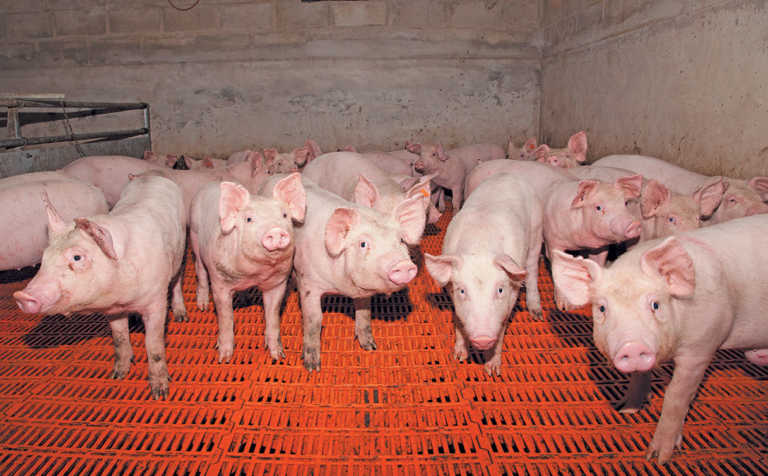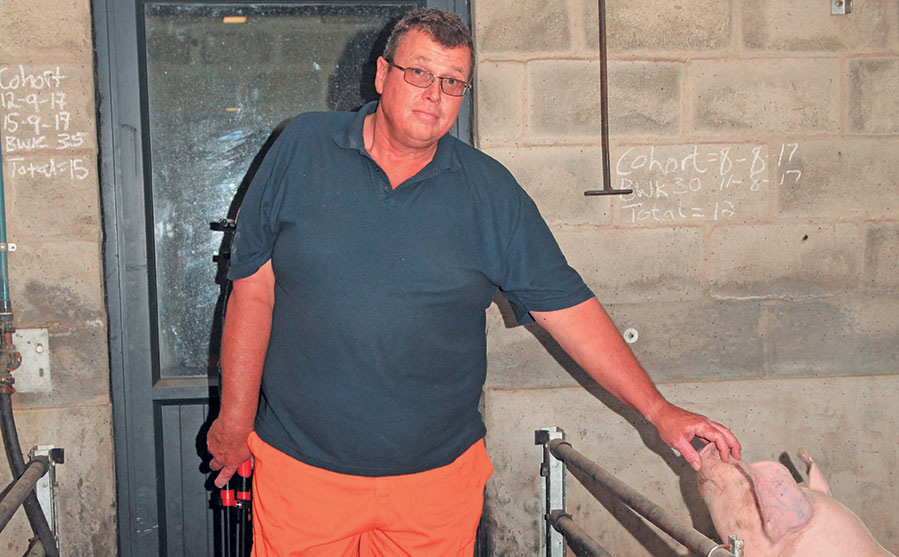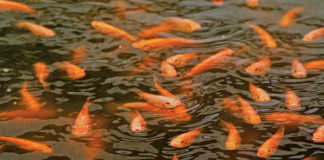
Photo: Glenneis Kriel
Studies have proved that stress can have a negative impact on reproduction, growth and health in livestock.
At Chalala Farms, situated in the Swartland, which forms part of Number Two Piggeries, great care is therefore taken to keep pigs as stress-free as possible, according to manager Jeff van Zyl.
READ Sows on heat: guidelines to follow
This approach also helps to satisfy consumers, who are becoming increasingly concerned about animal welfare and the origins of their food, he says.
To this end, pigs at Chalala Farms are kept in a comfortable environment. According to Jeff, mature pigs do best at temperatures between 18ºC and 20ºC and humidity levels of 60% to 80%.
“They can tolerate temperatures up to 25ºC, but anything above that has been found to have a negative impact on growth, farrowing rates, litter sizes and even the number of stillbirths,” he explains.

Chalala Farms uses evaporative cooling pads to reduce the air temperature in the production units, while fans are used to disperse the air evenly throughout the building.
For mature pigs, the temperature is maintained at 23ºC. No heating equipment is required in these units, as climatic conditions in the Swartland rarely make it necessary.
Piglets, on the other hand, do require heating, and infrared spot heaters are used in farrowing pens for this purpose. The heaters are placed about 50cm from the sows, keeping the piglets warm while enabling the sows to remain reasonably cool.
Infrared wall units and a warm water system operating with radiation tubes and heat pumps are used to heat the weaner pens.
The temperature is maintained at 29ºC when the piglets enter the units, but this is reduced between 0,5ºC and 1ºC per week over their seven-week stay.
All piglets destined for breeding at Chalala Farms are kept on site in a specialised, closed gilt rearing facility, while those being prepared for the market are moved to a separate weaner facility. Slaughter animals are sold at 21 weeks.
Health management
Every possible precaution is taken to ensure that the pigs remain healthy and do not contract any diseases, Jeff says. This starts with a clean environment. Slatted concrete floors are installed for mature pigs, while plastic slats are used for the younger animals.
Waste falls through the slats, collecting in a pit underneath from where it runs off to a manure treatment plant. Here the solids and fluids are separated and used as fertiliser in grain production.
According to Jeff, the plastic slats are warmer to lie on and more comfortable. Sows, however, are kept on cast-iron slats in the farrowing unit, as they are too heavy for the plastic slats.
The units are thoroughly cleaned, disinfected and dried after a group of pigs leave the unit and before a new batch is introduced. Once the pigs enter a unit, there is little need for cleaning the drinking or feeding equipment as the feeding buckets are flushed with water regularly.
Workers, nonetheless, keep an eye on the feeders and drinkers to identify problems and will clean these if necessary.
The water supplied to the farm is tested twice a year for quality. “It’s generally of a good quality, but sometimes we have to chlorinate it to reduce bacterial counts,”says Jeff.
Stringent biosecurity and access controls are enforced throughout the production facility to prevent the introduction and spreading of diseases.
Each of the three piggery sites is surrounded by a double fence separated by an open strip of land.
“Anybody or anything that enters the premises has to be disinfected,” stresses Jeff.
When people enter the farm, they are required to shower and leave their clothes at the entrance to the shower. On the other side of the shower, they don clean clothing supplied by the farm.
In addition, everyone must use designated footpaths when walking between the production units to prevent the spread of disease from one unit to another.
Chalala Farms has been registered with South Africa’s pig compartmentalisation system, which is aimed at controlling the spread of disease.
It requires that production areas be divided into zones to contain disease outbreaks, thus ensuring that imports from the entire country are not suspended following an outbreak in one location.
These diseases include classical swine fever, porcine reproductive and respiratory syndrome, and endemic diseases, such as African swine fever and foot-and-mouth disease.
To qualify, the farm must be audited annually to ensure that it adheres to certain minimum biosecurity requirements and management practices. Compartments are monitored by state veterinarians at least every second month to ensure they comply with the requirements.
“The main benefit of compartmentalisation is that it allows unaffected piggeries that are registered under the system, and comply with certain requirements, to continue exports when there is an outbreak of a notifiable disease in the country, albeit only to countries that recognise the compartmentalisation system.”
Chalala Farms exports to other countries in Southern Africa, Indian Ocean islands and also the Far East, Jeff explains.
Disease prevention
Pigs on the farm are vaccinated against a number of diseases. A combined parvovirus, leptospirosis and erysipelas vaccination is administered to sows at the start of every cycle to prevent diseases that could cause reproductive problems and birth complications.
Sows are also vaccinated against Escherichia coli, while piglets receive vaccinations against circovirus. According to Jeff, antibiotics are used only when pigs fall ill and medication is given to grower pigs only until they are 18 weeks old.
Feeding regime
The pigs receive rations formulated by a nutritionist and adapted according to their specific productive stage. The main feeding objective with sows is to maintain body condition for optimal reproduction.
READ Investing in animal welfare pays off for German piggery
Their production performance is measured during and after artificial insemination and they receive individualised quantities of feed based on body condition. Condition is measured again eight weeks after insemination.
The specialised computer program used to facilitate production also alerts Jeff to sows that are not eating enough.
“The sows are electronically tagged and the electronic feeder reads the tag to ensure that the sow receives the correct volume of feed,” he explains.
“We group the gilts together and then have them move through the feeding stations to the other side of the pen to identify those that do not know how to use the feeding stations. These are then lured into the feeding station with food pellets. Pigs are smart and usually learn how to use the feeding stations within a day,” Jeff says.
Pigs raised for the pork market are fed ad lib using a mechanical system that automatically fills feeders. Multiple pigs can feed easily at one of these feeders at a time. Weaners are also fed ad lib.
Jeff explains that the challenge with young piglets is that their digestive systems are still undeveloped, which makes them susceptible to stomach upset and problems. While piglets on some farms are weaned at 21 days, those at Chalala Farms are removed from the farrowing pens only when they are 28 days old.
“This helps to reduce weaning shock and ensure that the piglets have a strong constitution when they’re moved to the weaning units,” he says.
Piglets who fail to suckle are identified in the farrowing pens and placed on the teats of the sows to ensure they have access to enough milk. Additional milk formula is supplied when piglets do not get enough milk from their mothers. Creep feed is introduced to help them get used to solids from 10 days old.
When the piglets are moved to the weaner pens, the smallest 20% are grouped together to receive additional feed. The rest are started out on an easy-to-digest high starch ration, which is adapted five times during their growth period.
Organic acids are also mixed into the feed rations. Jeff explains that these organic acids help to balance the pH level of the piglets’ stomachs, “making the stomach environment less susceptible to bacterial growth”.
Industry certification
Chalala Farms has also attained Pork360 certification, which means that production practices, use of medication, biosecurity, feeding regimes, transportation and animal welfare standards comply with certain minimum industry standards.
The production facility is audited annually to ensure that these standards are maintained.
The farm has opted for group housing rather than stalls, with sows staying in small units only during artificial insemination (AI).
Three days after AI, and five days before farrowing, they are moved to group housing, which means they are kept in group housing for twice as long as required by industry standards.
In the group housing system, each sow has access to an individual stall that it can open and close by itself, but which cannot be opened by another pig if it is already occupied.
Here, sows have access to their own feeders so that they do not have to compete for food.
A stocking density of 0,35 animals/m2 is maintained in the weaner pens and 0,95 animals/m2 in the growing pens.
Email Jeff van Zyl at [email protected].











